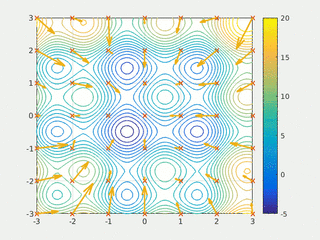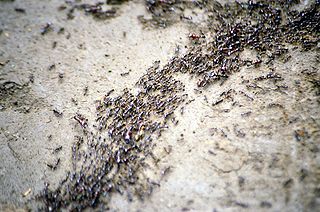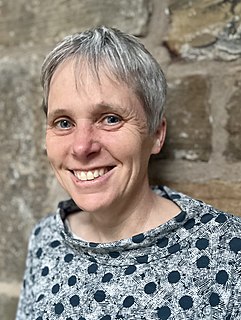Related Research Articles
In artificial intelligence, genetic programming (GP) is a technique of evolving programs, starting from a population of unfit programs, fit for a particular task by applying operations analogous to natural genetic processes to the population of programs.

In computer science and operations research, a genetic algorithm (GA) is a metaheuristic inspired by the process of natural selection that belongs to the larger class of evolutionary algorithms (EA). Genetic algorithms are commonly used to generate high-quality solutions to optimization and search problems by relying on biologically inspired operators such as mutation, crossover and selection. Some examples of GA applications include optimizing decision trees for better performance, solving sudoku puzzles, hyperparameter optimization, etc.
In computational intelligence (CI), an evolutionary algorithm (EA) is a subset of evolutionary computation, a generic population-based metaheuristic optimization algorithm. An EA uses mechanisms inspired by biological evolution, such as reproduction, mutation, recombination, and selection. Candidate solutions to the optimization problem play the role of individuals in a population, and the fitness function determines the quality of the solutions. Evolution of the population then takes place after the repeated application of the above operators.

In computer science, evolutionary computation is a family of algorithms for global optimization inspired by biological evolution, and the subfield of artificial intelligence and soft computing studying these algorithms. In technical terms, they are a family of population-based trial and error problem solvers with a metaheuristic or stochastic optimization character.

In computational science, particle swarm optimization (PSO) is a computational method that optimizes a problem by iteratively trying to improve a candidate solution with regard to a given measure of quality. It solves a problem by having a population of candidate solutions, here dubbed particles, and moving these particles around in the search-space according to simple mathematical formula over the particle's position and velocity. Each particle's movement is influenced by its local best known position, but is also guided toward the best known positions in the search-space, which are updated as better positions are found by other particles. This is expected to move the swarm toward the best solutions.
NeuroEvolution of Augmenting Topologies (NEAT) is a genetic algorithm (GA) for the generation of evolving artificial neural networks developed by Ken Stanley in 2002 while at The University of Texas at Austin. It alters both the weighting parameters and structures of networks, attempting to find a balance between the fitness of evolved solutions and their diversity. It is based on applying three key techniques: tracking genes with history markers to allow crossover among topologies, applying speciation to preserve innovations, and developing topologies incrementally from simple initial structures ("complexifying").

In computer science and operations research, the ant colony optimization algorithm (ACO) is a probabilistic technique for solving computational problems which can be reduced to finding good paths through graphs. Artificial ants stand for multi-agent methods inspired by the behavior of real ants. The pheromone-based communication of biological ants is often the predominant paradigm used. Combinations of artificial ants and local search algorithms have become a method of choice for numerous optimization tasks involving some sort of graph, e.g., vehicle routing and internet routing.
Collaborative intelligence characterizes multi-agent, distributed systems where each agent, human or machine, is autonomously contributing to a problem solving network. Collaborative autonomy of organisms in their ecosystems makes evolution possible. Natural ecosystems, where each organism's unique signature is derived from its genetics, circumstances, behavior and position in its ecosystem, offer principles for design of next generation social networks to support collaborative intelligence, crowdsourcing individual expertise, preferences, and unique contributions in a problem solving process.
Swarm intelligence (SI) is the collective behavior of decentralized, self-organized systems, natural or artificial. The concept is employed in work on artificial intelligence. The expression was introduced by Gerardo Beni and Jing Wang in 1989, in the context of cellular robotic systems.

Learning classifier systems, or LCS, are a paradigm of rule-based machine learning methods that combine a discovery component with a learning component. Learning classifier systems seek to identify a set of context-dependent rules that collectively store and apply knowledge in a piecewise manner in order to make predictions. This approach allows complex solution spaces to be broken up into smaller, simpler parts.
In evolutionary computation, a human-based genetic algorithm (HBGA) is a genetic algorithm that allows humans to contribute solution suggestions to the evolutionary process. For this purpose, a HBGA has human interfaces for initialization, mutation, and recombinant crossover. As well, it may have interfaces for selective evaluation. In short, a HBGA outsources the operations of a typical genetic algorithm to humans.
Interactive evolutionary computation (IEC) or aesthetic selection is a general term for methods of evolutionary computation that use human evaluation. Usually human evaluation is necessary when the form of fitness function is not known or the result of optimization should fit a particular user preference.
A memetic algorithm (MA) in computer science and operations research, is an extension of the traditional genetic algorithm. It may provide a sufficiently good solution to an optimization problem. It uses a local search technique to reduce the likelihood of premature convergence.
Human-based computation (HBC), human-assisted computation, ubiquitous human computing or distributed thinking is a computer science technique in which a machine performs its function by outsourcing certain steps to humans, usually as microwork. This approach uses differences in abilities and alternative costs between humans and computer agents to achieve symbiotic human–computer interaction. For computationally difficult tasks such as image recognition, human-based computation plays a central role in training Deep Learning-based Artificial Intelligence systems. In this case, human-based computation has been referred to as human-aided artificial intelligence.
A hyper-heuristic is a heuristic search method that seeks to automate, often by the incorporation of machine learning techniques, the process of selecting, combining, generating or adapting several simpler heuristics to efficiently solve computational search problems. One of the motivations for studying hyper-heuristics is to build systems which can handle classes of problems rather than solving just one problem.
Design Automation usually refers to electronic design automation, or Design Automation which is a Product Configurator. Extending Computer-Aided Design (CAD), automated design and Computer-Automated Design (CAutoD) are more concerned with a broader range of applications, such as automotive engineering, civil engineering, composite material design, control engineering, dynamic system identification and optimization, financial systems, industrial equipment, mechatronic systems, steel construction, structural optimisation, and the invention of novel systems.
In applied mathematics, multimodal optimization deals with optimization tasks that involve finding all or most of the multiple solutions of a problem, as opposed to a single best solution. Evolutionary multimodal optimization is a branch of evolutionary computation, which is closely related to machine learning. Wong provides a short survey, wherein the chapter of Shir and the book of Preuss cover the topic in more detail.

Professor Emma Hart is an English computer scientist known for her work in Artificial Immune Systems (AIS), evolutionary computation and optimisation. She is a professor of computational intelligence at Edinburgh Napier University, editor-in-chief of the Journal of Evolutionary Computation, and D. Coordinator of the Future & Emerging Technologies (FET) Proactive Initiative, Fundamentals of Collective Adaptive Systems.
Multi-task optimization is a paradigm in the optimization literature that focuses on solving multiple self-contained tasks simultaneously. The paradigm has been inspired by the well-established concepts of transfer learning and multi-task learning in predictive analytics.
Memetic computing is a novel computational paradigm that incorporates the notion of meme(s) as basic units of transferable information encoded in computational representations for boosting the performance of artificial evolutionary systems in the domain of search and optimization.
References
- ↑ Kosorukoff (1998) Alex Kosorukoff, Free Knowledge Exchange, human-based genetic algorithm on the web archive description
- The Kaieteur Institute for Knowledge Management (2001), Categories of digital knowledge exchanges online
- Kosorukoff, A (2001), Human-based Genetic Algorithm. IEEE Transactions on Systems, Man, and Cybernetics, SMC-2001, 3464-3469
- Hideyuki Takagi (2001), Interactive Evolutionary Computation: Fusion of the Capabilities of EC Optimization and Human Evaluation, Proceedings of the IEEE, vol.89, no. 9, pp. 1275–1296
- Kosorukoff, A. & Goldberg, D. E. (2001) Genetic algorithms for social innovation and creativity (Illigal report No 2001005). Urbana, IL: University of Illinois at Urbana-Champaign online
- Kosorukoff, A, Goldberg D. E. (2002), Genetic algorithm as a form of organization, Proceedings of Genetic and Evolutionary Computation Conference, GECCO-2002, pp 965–972
- Ajwani, D et al. (Eds) Fast Track to The Social Web, Digit magazine, August 2007 p. 116 online
- Gloor, P et al. (2008) MIT Handbook of collective intelligence, Examples of collective intelligence online
- Javadi, E.; Gebauer, J. "Collaborative Knowledge Creation and Problem Solving: A Systems Design Perspective," System Sciences, 2009. HICSS '09. 42nd Hawaii International Conference on, vol., no., pp. 1–10, 5-8 Jan. 2009 doi: 10.1109/HICSS.2009.111